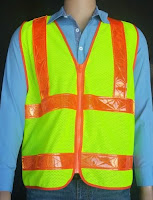New ANSI/ISEA 107-2015 Standards
What is the difference?


Safety Vest come in many shapes, styles, and colors. Some with and some with out reflective, hook & loop, zippers....so are you buying the right vest for your application?
We can read the ANSI/ISEA guideline, but it can get rather confusing to someone who just wants to know which vest to buy. The standard is updated every 5 years. The new standard is being released this month, and the biggest change you will see is everyone buying Class 2 or Class 3 will now buy your vest by a Type and class. Sound confusing? Lets break it down. It sounds more intimidating that it really is.
Old Standard (107-2010) vs New Standard (107-2015)
Class 1 - This is a basic vest with very little reflective. The vest itself must be made of at least 217 square inches of fabric, (orange, red-orange or lime ANSI Approved) and 155 square inches of **retroreflective or combined performance material.
There is not a huge demand for Class 1 since the MUTCD requires anyone on a roadway to wear at least ANSI/ISEA 107-2004 Class 2.
In the new 107-2015 Standard the Class 1 will now be a Type O (Off-Road and Non-Roadway Use) This will open this standard up to be used more by construction workers in areas that are not connected to roadways, and to other jobs that require a safety vest, but does not require you to work near a roadway.
Class 2 - This is the most popular standard. The current MUTCD references the ANSI 107-2004 Class 2 as the required standard for road way use. Your city, county or state may require more. The Class 2 must contain 775 square inches of fabric, (orange, red-orange or lime ANSI Approved) and 201 square inches of **retroreflective or combined performance material.
The new standard 107-2015 will now be Type R (Roadway and Temporary Traffic Control Zones) It will have two classes, Class 2, that we have mentioned above and will require the same amount of reflective and background and will now included the Class 3.
I want to take a few minutes here to talk about ANSI Class 3 garments. There are several misconceptions. Class 3 Garments must show limb movement, what does this mean? You must have arms in your vest with reflective around the arm, OR you must wear a Class 2 vest with Reflective pants, shorts or gaiters. This is the only way to meet Class 3 Standards, people must be able to see either your arms or legs moving because you have reflective on them.
Class 3 will fall under Type R (Roadway and Temporary Traffic Control Zones) and must be made of at least 1240 square inches of fabric, (orange, red-orange or lime ANSI Approved) and 310 square inches of **retroreflective or combined performance material. If you wear a Class 2 vest that contains 201 square inches of reflective you must have at least 109 square inches of reflective around your arms or legs.
ANSI announced a new standard in 2006 that was to be used only by Public Safety employees. These employees include Officers, Fire, EMS, and anyone who can be considered a first responder. This standard is the ANSI/ISEA 207-2011 Public Safety Standard. ANSI created this standard to allow people wearing duty belts easier access to their belts by making the vest smaller. This vest only required 450 square inches of fabric, (orange, red-orange or lime ANSI Approved) and 201 square inches of **retroreflective or combined performance material There are no classes in this standard.
The new 107-2015 standard will absorb public safety so there will no longer be a 207-2011 standard.
Under the 107-2015 standard you will now find Type P (Emergency and Incident Responders and Law Enforcement Personnel) in a Class 2 and Class 3
The Public safety vest was not offered in a Class 3 garment before now, remember this means it must have sleeves or some type of leg reflective. Type P Class 3 requires at least 775 square inches of fabric, (orange, red-orange or lime ANSI Approved) and 310 square inches of **retroreflective or combined performance material.
If you wear a Type P Class 2 vest that contains 201 square inches of reflective you must have at least 109 square inches of reflective around your arms or legs.
Supplemental Items such as Hats, overalls, pants, shorts and gaiters are listed under ANSI Class E (ensemble) These items requires at least 465 square inches of fabric, (orange, red-orange or lime ANSI Approved) and 109 square inches of **retroreflective or combined performance material.
One of the largest complaints about safety vest up to this point is that smaller people could not get a vest that fit correctly. Due to the background requirements the smallest vest that would meet ANSI specifications was a size medium. The new 107-2015 standard has address this issue and will now allow for small sizes to be made under Type R Class 2 and Class 3.
Type R Class 2 Size Small will require at least 540 square inches of fabric, (orange, red-orange or lime ANSI Approved) and 201 square inches of **retroreflective or combined performance material.
Type R Class 3 Size Small will require at least 775 square inches of fabric, (orange, red-orange or lime ANSI Approved) and 310 square inches of **retroreflective or combined performance material.








